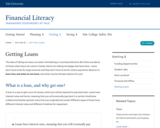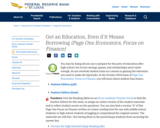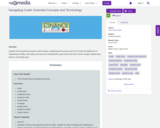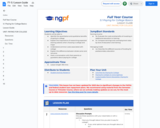
Attribution: College Matchpoint.
- Subject:
- Career and Technical Education
- Material Type:
- Reading
- Author:
- Aujalee Moore
- Date Added:
- 05/20/2024

Attribution: College Matchpoint.

This course provides a solid understanding of consumer decision-making and how new products and services are developed, especially given the rapid pace of innovation and regulatory change, to help students succeed in consumer finance today. Specific examples will be drawn from retirement saving products, credit cards, peer to peer lending, cryptocurrencies, and financial advising.

This activity allows the students to discuss the burden of student loans and financing post-secondary education. An additional aspect to this activity is the mental health aspect regarding heavy debt loads for post-secondary. The discussion could include a debate on student loans, who is responsible and can a student "walk away" from this debt? Should the government pay for post-secondary education for everyone? If yes, would you be willing to pay more taxes for free post-secondary education?
Students often finance their post-secondary education, which can be very expensive over many years. How does a student pay this debt back if they are unable to finish their program, especially in expensive programs such as medicine or law?

Students will be able to
- Explain the role the FAFSA plays in the financial aid process
- Understand the importance of submitting the FAFSA
- Apply for the FAFSA
- Identify misconceptions and challenges students have that prevent them from submitting the FAFSA
- Read a Student Aid Report (SAR) and understand the role of their Expected Family Contribution (EFC)

The idea of taking out loans can seem intimidating or counterproductive. But there are plenty of times when loans can come in handy. We’re not talking mortgage size loans here – loans don’t have to be for large amounts and they don’t have to be for tuition payments. Read on to learn how and when to use loans, and what may be the best options for you!

You may be doing all you can to prepare for the price of education after high school, but if your savings, grants, and scholarships aren’t quite enough, do not overlook student loans as a means to gaining the education you need to make the big bucks.

Students will comprehend essential credit concepts, emphasizing the purpose and role of credit, the significance of maintaining a healthy credit rating, and key terms including APR, grace period, late fees, finance charges, default rates, interest, and closing costs.

Overview: Students will be able to
- Identify the quantitative and qualitative benefits of going to college
- Explain the importance of researching expected starting salaries when choosing a college and major
- Understand common costs associated with college
- Explain the difference between sticker price and net price
- Have a conversation with their parents or guardians about paying for college

This lesson is divided into two student readings. The first reading compares the scope of the present student debt crisis with the past and discusses what has changed. The second reading explores some proposals for dealing with the student debt crisis. Discussion questions aimed at getting students to think critically about the student debt problem and its possible solutions follow each reading.

Students will be able to
Understand the rising national trends in student debt
Compare federal and private loans and explain what it means to take out each type of loan
Identify various strategies they can use to be a responsible borrower
Analyze three student profiles to determine the best course of action to take for their student loans